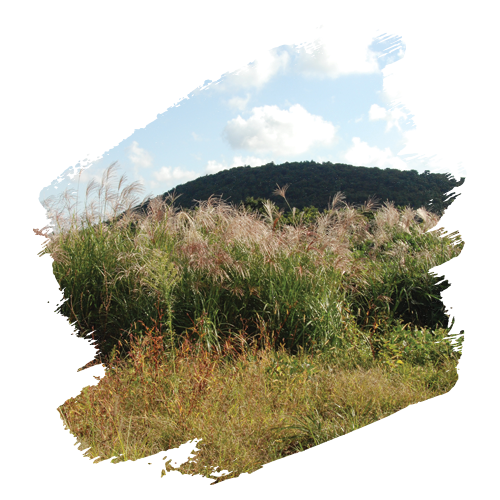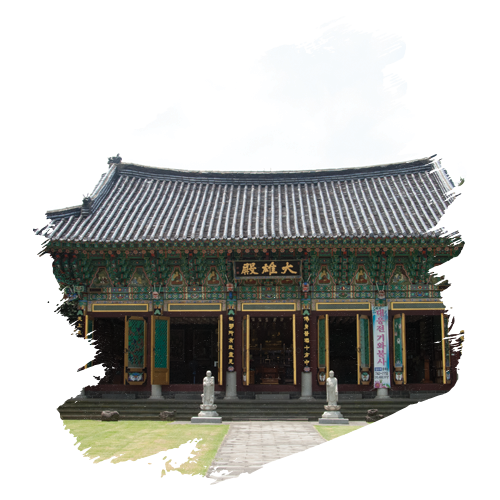The Jeju 4·3 Trails introduced overleaf provide a valuable opportunity to visit village sites and learn about how Jeju 4·3 impacted rural communities. The Donggwang Village Jeju 4·3 Trail, for example, take walkers to Keunneolgwe cave where locals hid during Jeju 4·3. There is also a route which takes visitors to Ora-ri, now the largely urbanized Ora-dong in Jeju City and the site of the infamous Ora-ri Arson in 1948. The Gasi Village Jeju 4·3 Trail in Pyoseon-Myeon also provides walkers the chance to learn about the tragic history of a landscape that is among Jeju’s most beautiful. These routes are still in the development stage and signage may not be as developed as some of the island’s other walking routes. Nevertheless, opportunities for tourists to learn about Jeju 4·3 are increasing as villagers seek to increase awareness of their own experience of this tragic chapter in local history.
Uigwi-ri Village Jeju 4·3 Trail (Namwon-eup)
During Jeju 4·3, the residents of Uigwi-ri village experienced severe oppression due to the initial hardline suppression by the army-police counterinsurgency forces. To survive, the villagers had no choice but to hide in nearby oreum (small volcanic cones), forests or caves. Many residents who were arrested were later either killed or sent to prisons on the Korean mainland. The majority of the victims are still missing, without any information on whether they survived or lost their lives.


Donggwang-ri Village Jeju 4·3 Trail (Andeok-myeon)
Donggwang-ri village in Andeok-myeon, southwest Jeju, was a focus of attention for the US military government after it attained control over the southern half of Korea following liberation from Japan in 1945. Villagers here were unhappy with the heavy taxation system and a government official was assaulted to protest against the burden placed on locals. After the outbreak of Jeju 4·3, numerous Donggwang-ri residents were arrested and eventually executed at the coastal cliff of Jeongbang Falls. It was nearly impossible to identify the deceased as the corpses either washed away or were piled atop one another. In total, more than 160 people from Donggwang-ri were killed during the Jeju Uprising and Massacre period.
Bukchon-ri Village Jeju 4·3 Trail (Jocheon-eup)
The massacre committed at Bukchon-ri village by the Korean Constabulary on Jan. 17, 1949, stands out for its brutality even among the horrors of the 4·3 period. Over 400 villagers were murdered by state forces in this corner of northeast Jeju as officers retaliated against the murder of two soldiers by rebels nearby. Houses were torched and people dragged to a local field where they were executed. Even those who fled were hunted down and executed the next day. The events would become the inspiration behind Hyun Ki-young’s 1978 novella “Sun-i Samch’ on.” The village today is renowned for its strong haenyeo (diving women) culture and community spirit.


Gasi-ri Village Jeju 4·3 Trail (Pyoseon-myeon)
Prior to the outbreak of Jeju 4·3, Gasi-ri village, a mid-mountain village famed for its horse pastures and bleak beauty, comprised nearly 360 households. However, the evacuation order and scorched-earth operation left the village in ruins. The villagers who had been caught after fleeing to the mountain, or the relatives of fugitives, were massacred by counterinsurgency troops near Hanmosal (Pyoseon Beach) and Beodeulmot (a pond once surrounded by willow trees).
Geumak-ri Village Jeju 4·3 Trail (Hallim-eup)
Geumak-ri village, an interior village in the mid-mountain “jungsangan” region, was established around 1550 by two clans from the mainland, the Kang family and the Hong family. Other families later settled here including the Yang, Park, Kim, Lee and Song clans. Despite this 400-year history, many of the settlements were razed, never to recover, as part of the government’s 4·3 counterinsurgency operations. Geumak-ri lost an estimated 300 homes with 152 residents massacred or missing. Many settlements never recovered including Utdongne and Donggareum.


Ora-ri Village Jeju 4·3 Trail (Jeju City)
Although Ora-ri village (now Ora-dong) is part of modern Jeju City, it was a rural community of thatched cottages at the time of Jeju 4·3, and it still boasts tranquil woodlands, volcanic cones and lush river valleys. Its day of infamy came on May 1, 1948, when the community was the victim of an arson attack that would intensify violence across the island. Although the arson was blamed on the armed resistance group, it was actually carried out by the Northwest Youth Association to scupper a peace deal agreed on April 28. Nevertheless, the attack precipitated intensified repression across the island by state forces, and footage of the arson filmed by the USAMGIK was used in a propaganda film titled “Cheju-Do May Day.” More than 240 Ora-ri residents lost their lives during Jeju 4·3 including two of the six people shot dead in the March 1 Shooting Incident at Gwandeokjeong Pavilion.